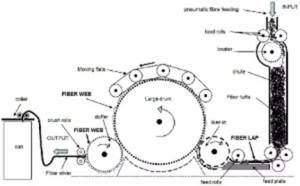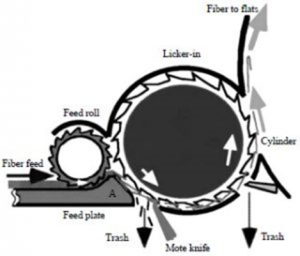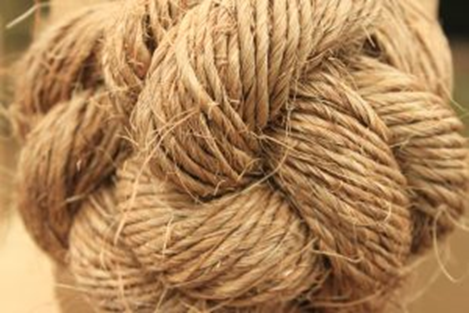Detail Study of Carding machine
Carding Machine Process

INTRODUCTION
“Card is the heart of the spinning mill” and “Well carded is half spun” are two proverbs of the textile experts. These proverbs inform the importance of carding in the spinning process. Very high production in carding to economies the process leads to reduction in yarn quality. Higher the production, the more sensitive becomes the carding operations in respect of the quality of carded sliver. The technological changes that had taken place in the process of carding are remarkable. Latest machines achieve the production rate of-
60 -175 kgs / hr, which used to be 5 – 10 kgs / hr, up to 1980 on conventional cards.
The objects of the carding machine:
– 1) Opening to individual fibers, this enables the elimination of impurities and performance of other operations.
– 2) Elimination of impurities occurs mainly in the region of the taker-in. The degree of cleaning achieved by modern cards is very high, in the range of 90 -95%. Thus, the overall degree of cleaning achieved by the blow-room and carding together is as high as 95 -99%.
Card sliver still contains 0.05 – 0.03% of impurities.
3) – Elimination of Dust, which are clinged to the fibers. Significant fiber/metal is also present. Therefore, fiber-to-fiber friction is needed in order to loosen such particles and these operations are available in carding.
4) Disentangling of neps, the number of neps increases from machine to machine in the blow- room, the card reduces the remaining number to a small fraction, they are mostly opened out. Improvement in disentangling of neps is obtained by closer spacing between wire clothing; sharper wire points; optimal speed of taker-in and low doffer speeds.
5) Elimination of short fibers, this may occur at flats. Long fibers have more contact with the wire points of the cylinder than the short fibers. Thus, longer fibers are continuously caught and carried along the cylinder, where the short fibers stay caught in the flats wire clothing, pressed into it and leave the flats in the flat stripping. The card eliminates very small percentage of short fibers about 1 percent.
6) Fiber blending, transverse blending occurs because the card is the only machine to handle individual fibers. In formation of the web, and with repeated rotation of the fibers on the cylinder, intimate fiber with fiber mixing is achieved.
7) Fiber orientation: The card is often attributed the effect of orientation. The orientation is achieved on cylinder, but it disappears during web formation between cylinder and doffer.
8) Sliver formation, for further processing. Generally, the hank lies between 4 and 5.5 Ktex in the short staple spinning mill.
CARDING PROCESS

The Cotton comes to the conventional Card Room in the form of a lap. In the Picker Room (Blow room) most of the heavier dirt and seeds were taken out. So the cotton as it comes to the Card contains, besides the good fiber to be manufactured, small bits of leaf, tangled knots of fiber and short fibers.
There are five principal parts to the card: Licker-in, cylinder, flats, doffer and coiler. The licker-in is covered with coarse teeth; the cylinder, flats and doffer are covered with hundreds of thousands of fine metallic wire points; the coiler is a device for delivering the cotton sliver.
The lap is unwound and fed to the licker-in, which removes those of the heavier impurities that by some chance escaped by the picker. From the licker-in, it is transferred to the cylinder and carried by the points of the wire on the cylinder past the wire on the flats.
This produces an action on the fibers similar to that of combing the hair and removes the remaining impurities, tangled knots and short fibers. The doffer takes the fibers from the cylinder, carries them to the front of the card, and condenses them into the form of an untwisted rope, known as sliver. This sliver is coiled in a can, this being a convenient form for the next Passage of material through carding
Lap is placed upon the wooden lap roller. Lap roller rotates at slow speed and the friction of lap roller and lap, unwinds the lap. Sheet of cotton now passes over the feed plate and passes under the feed roller and over the feed plate, which is heavily loaded to grip the cotton. Feed roller feeds the cotton sheet to the fast revolving licker-in. Grooved surface of the licker- in is clothed with saw tooth wire. Lap is now thoroughly well opened into very small tufts by the beating action of fast revolving licker- in.
The opened fiber tufts are carried by licker- in against mote knifes and over the under grid. Motes are the particles of sand, seed, leaf, boll, shale or stem. Due to the resistance of the mote knives heavy vegetable impurities known as motes and sand are removed and falls down through licker- in under casing. From licker- in, the fibers are transferred to the cylinder and carried forward towards the chain of flats (appox.110 flats) Cylinder is clothed with metallic wires and flats are clothed with flexible wires. The wire points of flats oppose the direction of the cylinder wire points, i.e., point vs. point wire system is placed between cylinder and flats. Flats rotates in the same direction of the cylinder but at very slow speed as compared to cylinder surface speed because of these reasons, carding action takes place between flats and cylinder, which means fiber to fiber separation is achieved.From cylinder, the carded fibers are transferred to the doffer surface, which is also clothed with metallic wire. Oscillating doffer comb operating close to the doffer removes the fibers from doffer in the form of thin sheet called “Web” which is gathered together by passing through trumpet to produce sliver, which is then compressed by a pair of table calendar rollers. In coiler head, the sliver is again, compressed by the coiler calender rollers.
Carding of MAN MADE FIBER
1.While the type of mam made fibers to be blended with any given cotton is decided on the basic of an end use.
2.The length of man made fiber should not be exceed 40-50 mm for blending.
3.The man made fibers required different blowroom and carding condition.
4.Normally,blending is done after carding as man made fibers do not have trash or impurities. however, some mills
5.Prefer blending at blowroom and carding for getting homogeneouslly mixing
of fiber.
Influencing factor:
6.Dm stock cannot be cleaned as well as a dry.
7. The high material through put reduces the cleaning effects and so does a thick feed sheet.
9.Cleaning Efficiency
cleaning efficiency of machine is the ratio of trash removed by the machine to that total trash feed to the machine expressed as percentage.
cleaning efficiency
Trash Removed
=———————————————————* 100
Trash Feed
Trash in Feed % – Trash in Delivery %
=———————————————————- *100
Trash in Feed%
10.The dirt content is usually determined with the aid of gravimetric method such as MDTAD,AFIS or Analysis.
11.The cleaning index is heavily,but not sovely, dependent on the dirt content.
12.The cleaning index may be different for cotton type with the same dirt and content.
CLWANINF FACTS
1.The larger the dirt particles ,the better they can be removed.
2.Dirt can be removed practically only from surfaces.
3.The higher the degree of opening that means the higher the degree of cleaning.
4.Avery high cleaning effect is always purchased at the cost of high fiber loss.
5.cleaning is made a more difficult, it the impurities of dirty cotton are distributed through a large quantity of material by mixing with clean cotton.
6.Higher roller speed gives a better cleaning effect but also more stress on fiber.
7.Cleaning efficiency is strongly dependent on trash.
8.It is also affected by the size of the particles and strictness of cotton.
9. Therfore cleaning efficiency can be different from different cotton with the same trash.
10. A high degree of opening in the blowroom faults takes cleaning in cleaning room.
Carding operation principles:
1.in modern installation raw material is supplied pipe daring into the feed and card
2.An every compressed bath of about 500-900 ktex is formed in a cute.
3. A transfer roller forward the bath to the feed arrangement.
4.Feed roller and feed plate designed to push the sheet of fiber slowly into the operating range of the licker in while maintaining optimum clamping.
5.The portion of the sheet projecting from the operating range of the licker in and opened into tufts by the licker in
6.This tufts are passed over grid equipment and transferred to the main cylinder.
7.in moving part of mote knife ,grid, carding segment etc. the material losses the majority of its impurities.
8.the suctions ducts carryout away the waste.
9. The tuft themselves are carried out along with the main cylinder and opened up into the individual fibers between the cylinder and tuft carding process.
10.The facts compressing 80-116 individual carding bass combined in to a belt moving on the endless bath.
11. now days, 30-46 of the flats are allocated in carding position relatively to main cylinder the rest are on the return run.
12. during this return the cleaning unit strips fiber neps and foreign matter from the bass.
13.fixed carding bass are designed to assist the operation of the card
14. grids or cover plate enclose the underside of main cylinder.,
15.After the carding operation has been completed the main cylinder carried along the fiber that are loose and lie parrellel without hook.
Technical details



